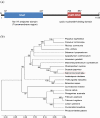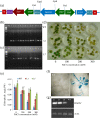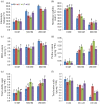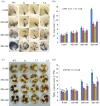The SbSOS1 gene from the extreme halophyte Salicornia brachiata enhances Na(+) loading in xylem and confers salt tolerance in transgenic tobacco
- PMID: 23057782
- PMCID: PMC3548769
- DOI: 10.1186/1471-2229-12-188
The SbSOS1 gene from the extreme halophyte Salicornia brachiata enhances Na(+) loading in xylem and confers salt tolerance in transgenic tobacco
Abstract
Background: Soil salinity adversely affects plant growth and development and disturbs intracellular ion homeostasis resulting cellular toxicity. The Salt Overly Sensitive 1 (SOS1) gene encodes a plasma membrane Na(+)/H(+) antiporter that plays an important role in imparting salt stress tolerance to plants. Here, we report the cloning and characterisation of the SbSOS1 gene from Salicornia brachiata, an extreme halophyte.
Results: The SbSOS1 gene is 3774 bp long and encodes a protein of 1159 amino acids. SbSOS1 exhibited a greater level of constitutive expression in roots than in shoots and was further increased by salt stress. Overexpressing the S. brachiata SbSOS1 gene in tobacco conferred high salt tolerance, promoted seed germination and increased root length, shoot length, leaf area, fresh weight, dry weight, relative water content (RWC), chlorophyll, K(+)/Na(+) ratio, membrane stability index, soluble sugar, proline and amino acid content relative to wild type (WT) plants. Transgenic plants exhibited reductions in electrolyte leakage, reactive oxygen species (ROS) and MDA content in response to salt stress, which probably occurred because of reduced cytosolic Na(+) content and oxidative damage. At higher salt stress, transgenic tobacco plants exhibited reduced Na(+) content in root and leaf and higher concentrations in stem and xylem sap relative to WT, which suggests a role of SbSOS1 in Na(+) loading to xylem from root and leaf tissues. Transgenic lines also showed increased K(+) and Ca(2+) content in root tissue compared to WT, which reflect that SbSOS1 indirectly affects the other transporters activity.
Conclusions: Overexpression of SbSOS1 in tobacco conferred a high degree of salt tolerance, enhanced plant growth and altered physiological and biochemical parameters in response to salt stress. In addition to Na(+) efflux outside the plasma membrane, SbSOS1 also helps to maintain variable Na(+) content in different organs and also affect the other transporters activity indirectly. These results broaden the role of SbSOS1 in planta and suggest that this gene could be used to develop salt-tolerant transgenic crops.
Figures









Similar articles
-
The SbMT-2 gene from a halophyte confers abiotic stress tolerance and modulates ROS scavenging in transgenic tobacco.PLoS One. 2014 Oct 23;9(10):e111379. doi: 10.1371/journal.pone.0111379. eCollection 2014. PLoS One. 2014. PMID: 25340650 Free PMC article.
-
In planta Transformed Cumin (Cuminum cyminum L.) Plants, Overexpressing the SbNHX1 Gene Showed Enhanced Salt Endurance.PLoS One. 2016 Jul 13;11(7):e0159349. doi: 10.1371/journal.pone.0159349. eCollection 2016. PLoS One. 2016. PMID: 27411057 Free PMC article.
-
The SbASR-1 gene cloned from an extreme halophyte Salicornia brachiata enhances salt tolerance in transgenic tobacco.Mar Biotechnol (NY). 2012 Dec;14(6):782-92. doi: 10.1007/s10126-012-9442-7. Epub 2012 May 26. Mar Biotechnol (NY). 2012. PMID: 22639284
-
From swamp to field: how genes from mangroves and its associates can enhance crop salinity tolerance.Mol Biol Rep. 2024 Apr 29;51(1):598. doi: 10.1007/s11033-024-09539-w. Mol Biol Rep. 2024. PMID: 38683409 Review.
-
Post-translational regulation of the membrane transporters contributing to salt tolerance in plants.Funct Plant Biol. 2021 Nov;48(12):1199-1212. doi: 10.1071/FP21153. Funct Plant Biol. 2021. PMID: 34665998 Review.
Cited by
-
Rhizobacterial Strain Bacillus megaterium BOFC15 Induces Cellular Polyamine Changes that Improve Plant Growth and Drought Resistance.Int J Mol Sci. 2016 Jun 21;17(6):976. doi: 10.3390/ijms17060976. Int J Mol Sci. 2016. PMID: 27338359 Free PMC article.
-
Genome-Wide Characterization and Expression Analysis of NHX Gene Family under Salinity Stress in Gossypium barbadense and Its Comparison with Gossypium hirsutum.Genes (Basel). 2020 Jul 16;11(7):803. doi: 10.3390/genes11070803. Genes (Basel). 2020. PMID: 32708576 Free PMC article.
-
HKT sodium and potassium transporters in Arabidopsis thaliana and related halophyte species.Physiol Plant. 2021 Apr;171(4):546-558. doi: 10.1111/ppl.13166. Epub 2020 Jul 23. Physiol Plant. 2021. PMID: 32652584 Free PMC article. Review.
-
A SNARE-Like Superfamily Protein SbSLSP from the Halophyte Salicornia brachiata Confers Salt and Drought Tolerance by Maintaining Membrane Stability, K(+)/Na(+) Ratio, and Antioxidant Machinery.Front Plant Sci. 2016 Jun 2;7:737. doi: 10.3389/fpls.2016.00737. eCollection 2016. Front Plant Sci. 2016. PMID: 27313584 Free PMC article.
-
A biostimulant prepared from red seaweed Kappaphycus alvarezii induces flowering and improves the growth of Pisum sativum grown under optimum and nitrogen-limited conditions.Front Plant Sci. 2024 Jan 8;14:1265432. doi: 10.3389/fpls.2023.1265432. eCollection 2023. Front Plant Sci. 2024. PMID: 38510831 Free PMC article.
References
-
- Epstein E, Bloom AJ. Mineral nutrition of plants: principles and perspectives. 2. Sunderland, Massachusetts: Sinauer Associations; 2005. pp. 342–351.
-
- FAO. FAO land and plant nutrition management service. 2008. http://www.fao.org/ag/agl/agll/spush/
-
- Wyn Jones RG, Pollard A. Encyclopedia of plant physiology. Berlin: Springer- Verlag; 1983.
-
- Hernández JA, Olmos E, Corpas FJ, Sevilla F, Del Río LA. Salt-induced oxidative stress in chloroplasts of pea plants. Plant Sci. 1995;105:151–167. doi: 10.1016/0168-9452(94)04047-8. - DOI
Publication types
MeSH terms
Substances
LinkOut - more resources
Full Text Sources
Miscellaneous

